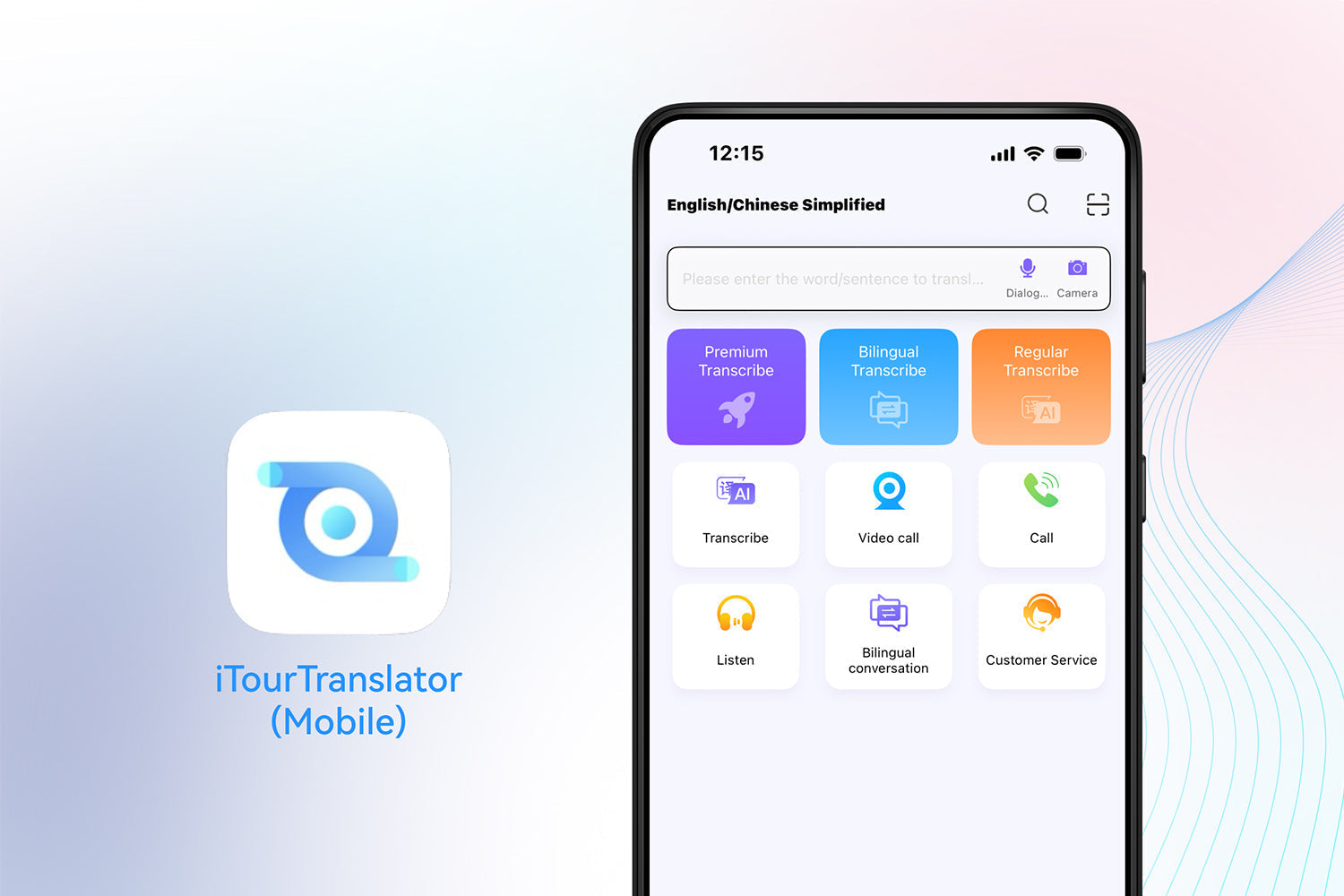Backpacking is one of the most liberating ways to explore the world. With a single bag, a flexible itinerary, and a spirit of adventure, backpackers can immerse themselves in local cultures and uncover hidden gems far from the usual tourist trails. But one challenge persists across all destinations: the language barrier.
Whether you're navigating a night market in Vietnam, asking for directions in the Italian countryside, or trying to understand a hostel receptionist in Morocco, clear communication can mean the difference between a smooth journey and a stressful one. That’s where translation earbuds come in.
But are they really suitable for backpackers? In this blog, we'll explore the functionality, benefits, and practical considerations of translation earbuds and why they are quickly becoming an essential item in the modern backpacker's toolkit.
1. The Language Barrier: A Constant Companion on the Road
When you're backpacking, you're likely hopping between countries, cultures, and dialects at a rapid pace. While English might help in major cities or tourist hotspots, it's far less reliable in remote villages, family-run hostels, or rural transit stations.
Translation apps have long been the go-to tool for travelers. However, these apps require your hands, your full attention, and often a stable internet connection—something not always available on the road. For backpackers looking to communicate quickly and naturally, stopping to unlock a phone and type a message is inconvenient and disruptive.
This is where translation earbuds show their strength. They allow for hands-free, real-time communication, enabling spontaneous conversations that feel more personal and authentic.
2. How Translation Earbuds Work
Before diving into their benefits, it's worth understanding how translation earbuds function.
These devices pair with a smartphone via Bluetooth and use AI-powered translation engines to convert spoken language into the listener's preferred language. Most models support bi-directional communication, meaning you and the person you're speaking with can each wear an earbud or use a speaker mode to converse naturally.
Advanced models support 40 -100+ languages, offer offline translation, and use context-aware algorithms to interpret slang, idioms, and accents more accurately than traditional apps.
In short, translation earbuds are not just for tourists—they’re for travelers who want meaningful interactions on the go.
3. Key Benefits for Backpackers
Now let's look at what makes these earbuds such a practical solution for long-term or budget-conscious travelers.
3.1 Hands-Free Convenience
Backpacking often means juggling a map, a water bottle, or your backpack at any given moment. With translation earbuds, there's no need to pause, pull out your phone, and type. You can ask for directions or order food while keeping your hands free and your focus on your surroundings.
3.2 Real-Time, Natural Conversations
Unlike translation apps, which operate in a clunky, one-sided format, earbuds allow for more natural conversation. You can speak and listen without breaking eye contact or interrupting the flow of dialogue. This improves not just communication, but the social connection that comes with it.
3.3 Offline Functionality
Many backpackers travel through areas with spotty or nonexistent Wi-Fi. Some translation earbuds come with downloadable language packs, allowing you to access core translation features without internet access. This is especially useful in mountainous regions, small towns, or developing areas.
3.4 Lightweight and Portable
Designed with travelers in mind, translation earbuds are compact and usually come with a portable charging case that fits easily into a daypack or even a pocket. With long battery life (15–25 hours) and fast-charging capabilities, they’re built for life on the move.
4. Use Cases in Backpacking Scenarios
Let's explore some common travel situations where translation earbuds prove invaluable.
4.1 Navigating Public Transportation
Figuring out which bus to catch in Bangkok or how to buy a train ticket in Prague becomes much easier when you can communicate with station staff in their native language.
4.2 Booking Local Accommodations
In many off-the-beaten-path hostels or guesthouses, English may not be spoken. Earbuds allow you to have a full conversation with your host—discussing check-in times, facilities, or even getting local recommendations.
4.3 Ordering Street Food or Dining Out
Backpackers often rely on local eateries and food stalls. Translation earbuds can help you read a menu or ask questions about ingredients—especially important for those with dietary restrictions or allergies.
4.4 Connecting with Locals
Some of the most memorable moments in backpacking come from unplanned conversations. Whether chatting with a local farmer or making a new friend at a cultural festival, earbuds remove the language barrier, enabling more genuine and heartfelt interactions.
5. Comparing to Traditional Translation Tools
While traditional tools like apps and phrasebooks have served travelers well, they often fall short in real-world situations. Let's explore how translation earbuds provide a more seamless and efficient alternative.
5.1 Apps vs. Earbuds
Apps require manual operation, which interrupts the natural rhythm of conversation. Earbuds offer a continuous, two-way flow of communication—ideal for dynamic travel settings.
5.2 Phrasebooks and Dictionaries
While traditional phrasebooks have nostalgic value, they lack flexibility and can't adapt to real-time situations. Earbuds provide a dynamic and responsive solution that doesn't require memorizing phrases or flipping through pages.
6. What to Look for in Translation Earbuds for Backpacking
Not all translation earbuds are created equal. Here are some key features backpackers should prioritize:
- Language Support: Choose earbuds that support 40+ languages and regional dialects.
- Offline Translation: Essential for areas with limited connectivity.
- Battery Life: Aim for at least 15 hours of use and a fast-charging case.
- Durability: Look for water-resistant or dustproof models for rougher environments.
- Comfort: Lightweight, ergonomic designs for long hours of wear.
- Compatibility: Ensure they sync smoothly with your mobile device and apps.
A thoughtful purchase can make the difference between a helpful gadget and a truly transformative travel companion.
7. Privacy and Security Concerns
Free translation apps often come with hidden costs—like data tracking or third-party access. Many premium earbuds offer on-device processing, meaning your conversations don't need to be uploaded to the cloud. For privacy-conscious travelers, especially in countries with strict data laws or political sensitivities, this feature adds peace of mind.
8. Are There Any Potential Drawbacks?
While translation earbuds offer many benefits, it's important to note a few limitations:
- Initial Cost: High-quality models may cost more upfront than free apps.
- Learning Curve: First-time users may need a few tries to get comfortable with the settings.
- Accent Variability: Some earbuds may struggle with heavy accents or unusual speech patterns, although newer models are increasingly accurate.
Despite these minor drawbacks, the value they provide in real-world travel scenarios far outweighs the limitations.
Conclusion
So, are translation earbuds suitable for backpackers? Absolutely.
They're light, practical, and designed for real-world use. They support more meaningful travel experiences, reduce stress, and help backpackers engage more deeply with the people and cultures they encounter. While traditional tools like apps and phrasebooks have their place, translation earbuds offer a smarter, more immersive solution for today’s global traveler.
If you’re planning your next big trip, consider adding translation earbuds to your gear list. With the right pair, the world really is yours to explore—no language required.



发表评论
此站点受 hCaptcha 保护,并且 hCaptcha 隐私政策和服务条款适用。